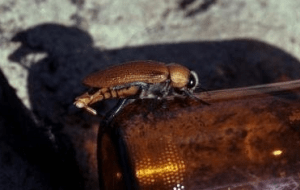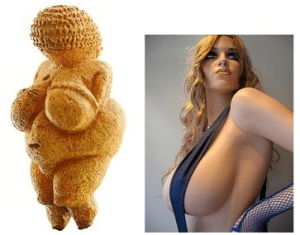This week, thousands of people swarmed the annual Consumer Electronics Show in Las Vegas. Looking from above, the scene resembled an insect infestation of scampering masses in a hive of the latest must-haves.
When considering our complex relationship with technology, perhaps it is useful to reflect upon the plight of one particular bug, the male julodimorpha beetle, who like us at times, can’t get enough of a bad thing. His misplaced desire is so powerful that it threatens the survival of his species.
While in flight, the male scans the dry ground of the Australian outback, looking for love. He seeks out the largest, reddest female he can find because these two traits, size and color, impart instinctual cues about the genetic fitness of his mate. Suddenly, the sight of his dream girl stops him mid-air. He composes himself and approaches the sultry beauty.
But the male of the species is not known for subtlety. Genitalia erect, he is ready for action and begins his lovemaking as soon as he lands on her. But his rude advances are rebuffed. However, he is determined to satisfy her, whether she is willing or not. He remains faithful, even as other suitable females pass him by. He wants only the biggest, the reddest and therefore, the most attractive female.
Undeterred, he keeps humping until either the sun bakes him to a crisp or the Australian Tyrant Ants cover his body and begin dismembering him limb from limb. Finally, he dies, never knowing that he unsuccessfully tried to impregnate a ravishingly beautiful bottle of beer.
Supernormal Stimuli

A julodimorpha beetle romances a discarded beer bottle.
To the julodimorpha beetle, the beer bottle’s size, hue, and dimpled bottom are an accentuated embodiment of female allure. His story of fatal attraction is tragic, but it is not uncommon. The phenomenon is known as “supernormal stimuli,” a term coined in the 1930s by the Dutch Nobel laureate Niko Tinbergen, to describe exaggerated features, which appeal to an animal’s evolutionary instincts but elicits stronger responses than the real thing. Supernormal stimuli is seen across many species, most notably, our own.
Tinbergen experimented with small songbirds who chose to sit on large fake eggs rather than their own brood. He saw male stickleback fish attack redder decoys more ferociously than they would real invaders. He also observed some animals who regularly deceive others with the technique. For example, the cuckoo bird is known for laying her eggs in different species’ nests, confident her slightly larger and brighter-colored young will spark instinctual cues to fool the host bird. The unsuspecting mother will nourish the larger cuckoo chick, thinking it is the biggest and therefore healthiest of her brood, meanwhile her own offspring starve to death.
We’re Cuckoos Too
Before mocking the gullibility of beetles, birds and fish, consider our own weakness for the things we perceive to be better than the real thing. Society and technology have evolved much faster than our instincts, leaving us vulnerable to the same kinds of adverse influences. But unlike lower animals duped by parasitic species, humans sell supernormal stimulus to each other for a profit.
Harvard psychologist Deirdre Barrett asserts that the technique influences our actions just as much as it does that of other animals. Television and movies portray juiced-up versions of relationships, allowing us to experience heightened emotion, connection and excitement, without all the effort of actually, you know, doing anything.
We’re captivated by video games which provide more exhilarating and purpose-driven versions of life. Dolls, anime characters and other objects of accentuated cuteness — think Hello Kitty and Precious Moments — use biological markers of natal helplessness like large eyes, flat noses, and large heads to entice children and grownups alike to purchase and care for them. Fast food is spiked with extraordinary quantities of sugar and fat, both extremely rare in nature, but also extremely delicious.
But perhaps the most common supernormal stimuli comes piped onto our screens and more recently, into our pockets, via our various digital devices. Our species’ beer bottle to hump seems to be our hunger for simulated sexual stimulation. The illusions created by flickering light on a screen are no more real than the beer bottle is to the beetle, yet digital pornography is a multi-billion dollar industry, which up until last year, timed its own industry convention to coincide with C.E.S.
Our penchant for making pleasurable things even better is nothing new. Some of the world’s oldest works of art provide evidence for the ancient appeal of supernormal stimuli. The Venus of Willendorf, estimated to have been carved from limestone some 25,000 years ago, depicts a female figure with exaggerated features including a detailed vulva and breasts large enough to make even today’s proportionally-enhanced porn stars blush. Historians theorize that the figure is the first in a long line of objects meant to capture the eye and arouse our desires. The creator of the Venus of Willendorf was not only one of the world’s first artisans, he was also among the first marketers.
The Mother of All Stimuli

Supernormal stimuli through the ages: The Venus of Willendorf (circa 24,000 BCE) and a modern-day lingerie mannequin.
But ever since cavemen began their naughty cave carving, there have been counterbalances to the effects of supernormal stimuli, which separate us from easily-fooled animals. Whereas julodimorpha beetles fornicate with their beloved beer bottle until death, humans quickly wise-up, get bored and move on.
Our brains come pre-installed with a piece of mental software which makes us tire of the old and seek out the new. It’s called “hedonic adaptation,” and it is the reason why lottery winners and paraplegics tend to revert to the same levels of happiness they felt before their respective life-changing events.
We adapt to our situation and our attraction to superficial features like breast size, sugar content, or screen resolution, fades when the object(s) of our desire become commonplace. We’re in love with our latest i-thing for a while, but soon realize it’s just another addition in our growing collection of future trash. Superficial traits may draw us in, but on their own, they lose their appeal.
However, our tendency to quickly adapt leaves us vulnerable to the one supernormal stimuli we find hardest to resist. Though we may cringe at the plight of the julodimorpha beetle or the host of the cuckoo bird’s egg, we are just as mesmerized by one particular traits we find equally enticing. It is why we line-up in droves at C.E.S., Apple stores and movie theaters and it is the stimuli embedded in the stories we tell and the games we play. The ultimate supernormal stimuli, as far as our species is concerned, is novelty.
Our insatiable curiosity is perhaps humanity’s greatest virtue, but it is also the source of many of our weaknesses. Pornography addicts need increasingly stimulating imagery to reach climax, spending hours searching for just the right titillation. Compulsive gamblers must take bigger risks, and incur bigger losses, to get the same fix. These are of course extreme examples, but they illustrate how we are all, to some degree, drawn to the insatiable enchantment of “more”. The new, new thing attracts us because of its mysterious potential, not its rationalized value.
Our salvation, as Dr. Barrett writes, comes from understanding. “Once we recognize how supernormal stimuli operate, we can craft new approaches to modern predicaments. Humans have one stupendous advantage over Tinbergen’s birds — a giant brain. This gives us the unique ability to exercise self-control, override instincts that lead us astray, and extricate ourselves from civilization’s gaudy traps.” Indeed, we begin to free ourselves from the pull of supernormal stimulus when we recognize it as such.
Photo Credits: Darryl Gwynne, Wikipedia, AskDaveTaylor, p-a-t-r-i-c-k
Related Articles
- Schedule Maker: a Google Sheet to Plan Your Week
- Cancel the New York Times? Good Luck Battling “Dark Patterns”
- How to Start a Career in Behavioral Design
- A Free Course on User Behavior
- User Investment: Make Your Users Do the Work
- Variable Rewards: Want To Hook Users? Drive Them Crazy
- The Hooked Model: How to Manufacture Desire in 4 Steps

